ZEN MESTEREK ZEN MASTERS
« Zen főoldal
« vissza a Terebess Online nyitólapjára

鳥巢道林 Niaoge Daolin (741-824)
[鳥窠道林 Niaoke Daolin]
(Rōmaji:) Chōka Dōrin
(English:) Bird's Nest Master
(Magyar:) Niao-ko Tao-lin (Madárfészkes mester)
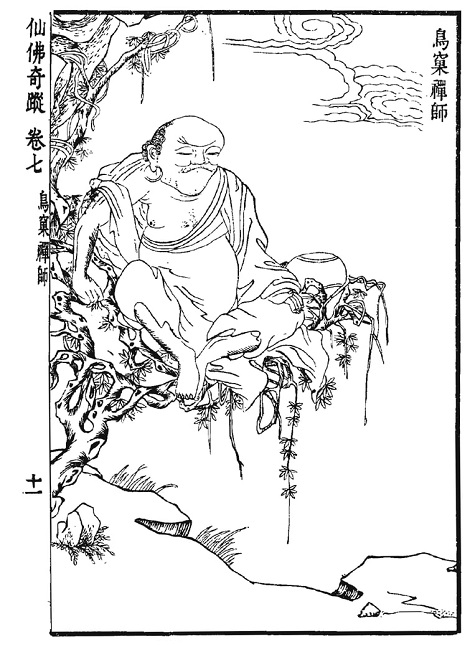
![]()
Niao Ko
by The Buddhist Yogi C. M. Chen
Offspring Ch'an, It's Portraits, Koans and Poems, CW33_No.92
http://www.yogichen.org/cw/cw33/bk092.html
Niao Ko always lives in a bird's nest. He has an attendant named Hui Tung who lives there close to his nest for many years. One day he takes leave from Niao. The latter asks, "Where shall you go?" Hui replies, "I became Bhikshu for the Ch'an but I did not get any teaching from you. So I have to seek another teacher." Niao Ko says, "If you are searching for Ch'an, I also have a little here." Thereupon he takes a tiny feather from the nest and blows it away. Hui Tung instantly comprehends.
Though it is a little feather
Beyond hither and thither,
For many years he is blind,
Now so easily to find!!
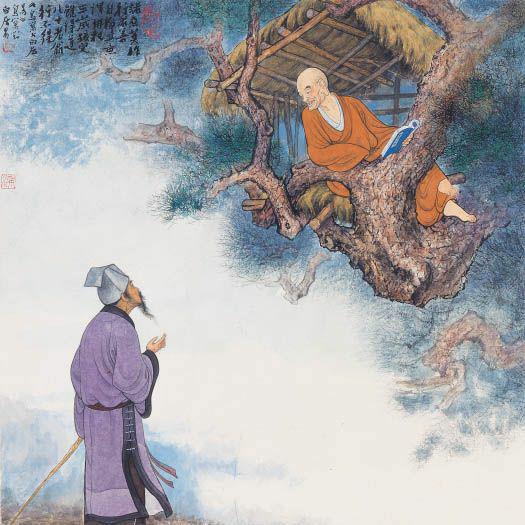
Painting by 高爾泰 Gao Ertai & 蒲小雨 Pu Xiaoyu
Niaoke and Bai Juyi
One day, the literary giant Bai Juyi paid a visit to Chan Master Niaoke Daolin. He saw the Chan Master sitting upright by a magpie’s nest, so he said, “Chan Master, living in a tree is too dangerous!”
The Chan Master replied, “Magistrate, it is your situation that is extremely dangerous!”
Bai Juyi heard this and, taking exception, said, “I am an important official in this imperial court. What danger is there?”
The Chan Master said, “The torch is handed from one to another, people follow their own inclinations without end. How can you say it’s not dangerous?” The meaning is to say that in officialdom, there are rises and falls, and people scheming against one another. Danger is right before your eyes. Bai Juyi seemed to come to some sort of understanding. Changing the subject, he then asked, “What is the essential teaching of the Dharma?”
The Chan Master replied, “Commit no evil. Do good deeds!” Hearing this, Bai Juyi thought the Chan Master would instruct him with some profound concept. Yet, they were just ordinary words. Feeling very disappointed, he said, “Even a three-year-old child knows this concept!”
The Chan Master said, “Although a three-year-old child can say it, an eighty-year-old man cannot do it.”
Although this “Gatha of the Seven Ancient Buddhas” looks trivial and ordinary, how many people are able to accomplish it? If everyone could refrain from evil, and moreover, actively do good, where would there still be evil in the human realm? How could society not be filled with love and joy? Since Bai Juyi listened to the Chan Master's words, he completely changed his egotistical and arrogant attitude.
斷根 Cutting the Root
http://tw.myblog.yahoo.com/larong-culture/article?mid=4728
唐代的道林禪師常年在一棵松樹上習禪,被人們稱為“鳥巢禪師”。一日,白居易慕名前去拜訪。見他住在樹上,便說:“禪師住的地方太危險!”“鳥巢禪師”回答說:“我看大人才危險呢!”
Zen master Daolin of the Tang Dynasty often practiced meditation up in a pine tree and was known as the “Bird Nest Zen Master.” Poet Bai Juyi (772–846) once paid him a visit out of admiration. Seeing the master living high up in the tree, he said: “Master, the place where you are living is quite dangerous!” The Bird Nest Zen Master replied: “The way I see it, Sir, it is you who are in danger!”
白居易不解地問:“我身為朝廷命官,何險之有?”
Perplexed, Bai Juyi asked: “I am an official in the royal court, why am I in danger?”
“鳥巢禪師”說:“世俗緣業相煎,冤冤相報,煩惱不息,難道不危險嗎?”
The Bird Nest Zen Master replied: “People in the secular world, driven by karma, harm each other continuously; they take turns avenging one another and breed endless afflictions. Aren't these situations dangerous?”
一句話,說得白居易啞口無言。
This simple answer rendered Bai Juyi dumbfounded.
是啊!世間之人時時為功名利祿所累,煩惱叢生,難道不是生活在看不見的監獄、魔網中嗎?難道不是很危險嗎?
It's so true! Ordinary people are always toiling for fame and wealth; they are constantly confused and worried. Aren't they living in an invisible prison or in the devil's web? Couldn't it be said that they are in grave danger?
速速逃離此險境吧!
Hurry! Run away from this dangerous place!
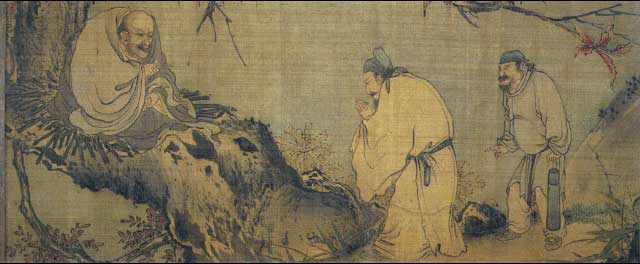
Painting by 梁楷 Liang Kai (c. 1140 - c. 1210)
Chan Master Niaoke Daolin in conversation with Bai Juyi 鳥窠道林禪師白居易問答圖
26.6 x 64.7 cm
Inscription:
When Chan Master Niaoke Daolin was resident in Qiantang, Bai Juyi came to into the mountains to question the master, saying: “Chan Master, your position is quite precarious!” The master replied: “The Provincial Governor is in far more danger.” Bai replied: “[Your] disciple is posted in Jiangshan township, how is that dangerous?” The mast er replied: “You know that kindling is always catching fire. How can that be safe?” 524 [Bai Juyi] asked another question: “What is the great insight of Buddhism?” The master replied: “Don't do anything bad, and do everything that's good.” Baijuyi replied: “A three - year - old child understands that kind of talk.” The master said: “A three year old child may be able to say it, but an eighty year old can't put it into practice.” Bai Juyi bowed, and left.
鳥窠道林禪師居錢唐時,白居易入山謂師曰: 「 禪師住處甚危險 」。 師云: 「 太守危 險尤甚 」。 白曰: 「 弟子位鎮江山何, 何險之有? 」 師云: 「 薪火相交識性不停。 得 非險乎?」又問:「如何是佛法大意?」 師云:「 諸惡莫作,眾善奉行。」 白曰。 「三歲孩兒也解與麼道。」 師曰:「三歲孩兒雖道得,八十老人行不得。」 白遂作禮 而退。
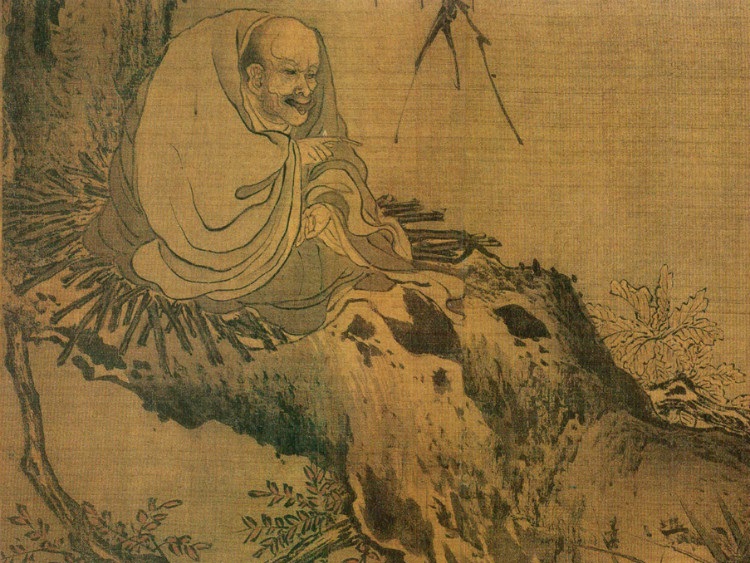
Pai Lê-t'ien and Niao-k'ê
Translated by D.T.Suzuki
In: Essays in Zen Buddhism (Third Series), Rider & Co., 1953, p. 368.
Pai Lê-t'ien [Pai Chü-i or Po Chü-i, 772–846] was a great poet of T'ang.
When he was officiating as governor in a certain district there was a Zen
master within his jurisdiction popularly known as Niao-k'ê, the "Bird's Nest,"
for he used to practise his meditation on a seat made of the thickly-growing
branches of a tree. The governor-poet once visited him and said, "What a
dangerous seat you have up in the tree?"
"Yours is far worse than mine"; retorted the master.
"I am the governor of this district, and I don't see what danger there
is in it."
"Then, you don't know yourself! When your passions burn and your
mind is unsteady, what is more dangerous than that?"
The governor then asked, "What is the teaching of Buddhism?"
The master recited this famous stanza:"Not to commit evils,
But to practise all good,
And to keep the heart pure -
This is the teaching of the Buddhas."Pai, however, protested, "Any child three years old knows that."
"Any child three years old may know it, but even an old man of
eighty years finds it difficult to practise it." So concluded the Zen master
up in the tree.
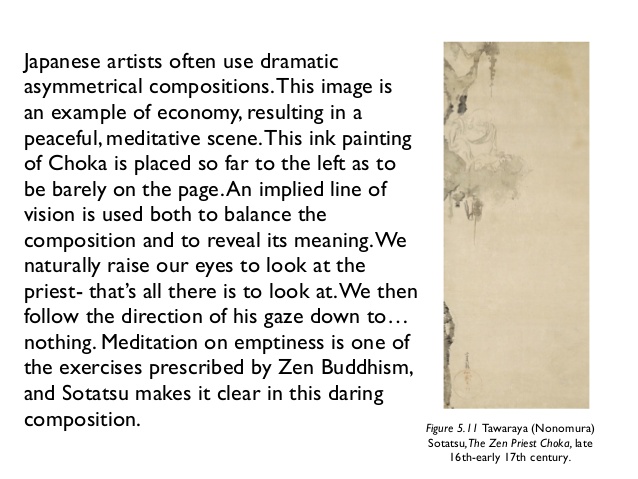
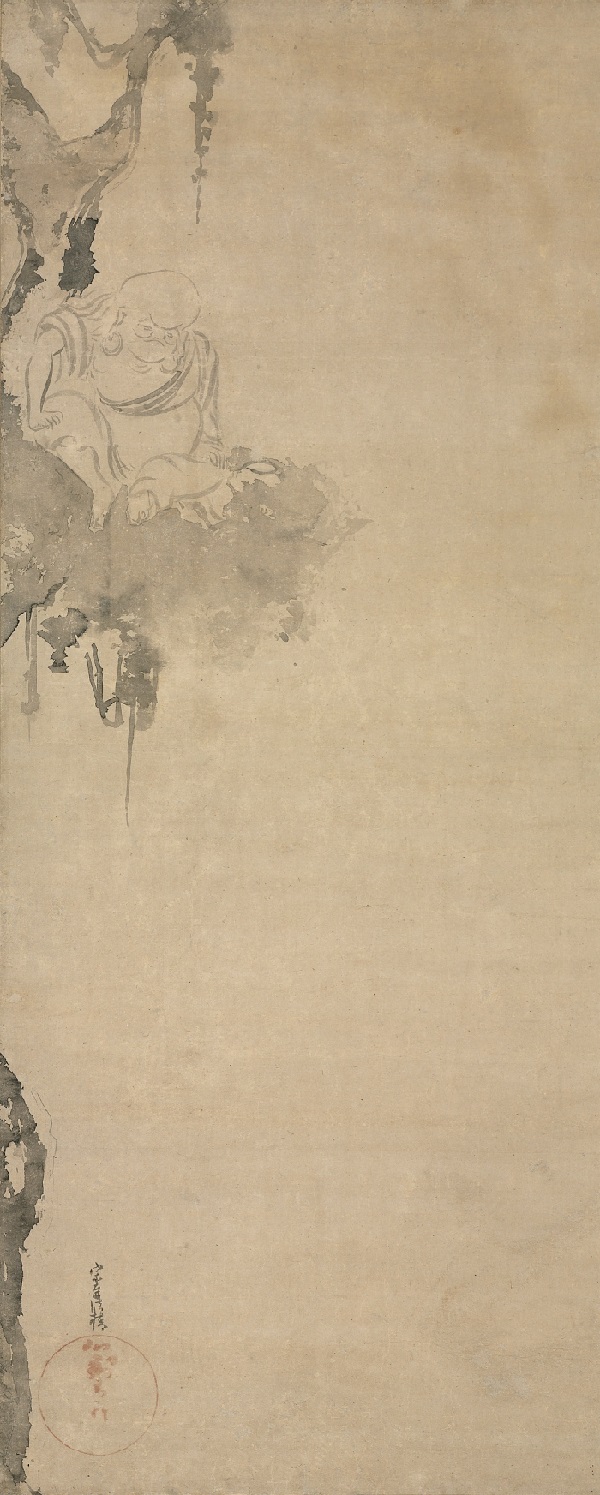
The Zen Priest Chōka
俵屋 宗達 Tawaraya Sōtatsu (c. 1570 – c. 1640)
Hanging scroll; ink on paper. Image: 95.8 x 38.7 cm
Cleveland Museum of Art, Norman O. Stone and Ella A. Stone Memorial Fund, 1958.289
Sōtatsu was a master of a "boneless" or unoutlined style of ink painting that relied on layered pools of ink wash for effect. A secular artist with no apparent religious motivation, Sotatsu exploited the design potential of this bizarre subject, a monk whom the artist conjured up like a genie from a bottle.
Niaoke, referred to in Japanese as Chōka, was a Chinese priest in the late Tang dynasty (618–907) and was said to meditate in treetops. He is perhaps best known for his exchanges with the Chinese poet Bai Juyi (772–846). Although some paintings capture both figures in dialogue, this work depicts Chōka alone; it is based on the 1602 Ming publication Marvelous Traces of Immortals and Buddhas (Chinese: Xianfo qizong ). Sōtatsu is believed to have studied the ink-painting methods of the thirteenth-century Chinese monk-painter Muqi (1210?–1269?). His own compositional skill, combined with his mastery of Muqi's approach to ink work, animates the otherwise drab book illustration in Marvelous Traces of Immortals and Buddhas . The Tawaraya studio obtained a copy of Marvelous Traces of Immortals and Buddhas soon after it was issued and produced a large number of ink paintings based upon the book's illustrations. The Cleveland work ranks as one of the most accomplished.
Chan Master Hangzhou Niaoke Daolin
景德傳燈錄 Jingde chuandeng lu (CDL)
鳥窠道林禪師 T.51, no.2076, 230b3 193 148 52
Daoyuan. Records of the Transmission of the Lamp: Volume 2 (Books 4-9), The Early Masters, Book 4.54
Translated by Randolph S. Whitfield
Chan master Niaoke Daolin (741-824 CE) was from Fuyang in Hangzhou and his family name was Pan. His mother, whose maiden name was Zhu, once dreamt of the rays of the sun entering her mouth, after which she conceived. When the baby was born a strange fragrance pervaded the room, so the name ‘Fragrant Light’ was given to the boy. He left the home life at the age of nine and received the full precepts at the Guoyuan Temple in Jing (Jingling, Hubei) when he was twenty-one years old. Later he went to the Ximing Monastery in Chang’an to study the Huayan Jing (Avatasaka Sūtra) and the Śāstra on the Arising of Faith (Śraddhotpada Śāstra, Aśvagoa) under the Dharma Teacher Fuli, who also introduced him to the Song of the Real and Unreal, and had him practise meditation.
Once Niaoke asked Fuli, ‘Could you say how one meditates and how to exercise the heart?’
Teacher Fuli was silent for a long time, so then the master bowed three times and withdrew.
It happened that at this time Tang Emperor Taizong had called the First Teacher in the Empire [Daoqin] of Jing Mountain to the Imperial Palace and Daolin went to pay him a formal visit, obtaining the True Dharma from him.
Returning south the master first came to the Yongfu Temple on Mount Gu (Zhejiang), where there was a stūpa dedicated to the Pratyekabuddhas. At this time both monks and laymen were gathering there for a Dharma-talk. The master also entered the hall, carrying his walking stick, which emitted a clicking sound. There was a Dharma-teacher present from a temple called Lingying, whose name was Taoguang, and who asked the master, ‘Why make such a sound in this Dharma-meeting?’
‘Without making a sound who would know that it was a Dharma-meeting?’ replied the master.
Later, on Qinwang Mountain, the master saw an old pine tree with lush foliage, its branches shaped like a lid, so he settled himself there, in the tree, which is why the people of that time called him Chan Master Niaoke (Bird’s Nest). Then magpies made their nest by the master’s side and became quite tame through the intimacy with a human – so he was also referred to as the Magpie Nest Monk.
One day the master’s attendant Huitong suddenly wished to take his leave. ‘Where are you off to then?’ asked the master.
‘Huitong left the home life for the sake of the Dharma, but the venerable monk has not let fall one word of instruction, so now it’s a question of going here and there to study the Buddha-dharma,’ replied Huitong.
‘If it could be said that there is Buddha-dharma,’ said the master, ‘I also have a little here,’ whereupon he plucked a hair from the robe he was wearing and blew it away. Suddenly Huitong understood the deep meaning.
During the Yuan reign period (806-820 CE) Bai Juyi was appointed governor of this commandery and so went to the mountain to pay the master a courtesy call. He asked the master, ‘Is not the Chan Master’s residing here very dangerous?’
‘Is not your Excellency’s position even more so?’ countered the master.
‘Your humble student’s place is to keep the peace along the waterways and in the mountains. What danger is there in that?’ asked Bai Juyi.
‘When wood and fire meet there is ignition – the nature of thinking is endless,’ replied the master, ‘so how can there not be danger?’
‘What is the essence of the Buddha-dharma?’ asked Bai.
‘To refrain from all evil and do all that is good,’ answered the master.
‘A three-year-old child already knows these words,’ said Bai.
‘Although a three-year-old can say them, an old man of eighty can’t put them into practice!’ countered the master.
Bai then made obeisance.
In the fourth year, during the tenth day of the second month of the reign period Changqing (824 CE), the master said to his attendant, ‘Now my time is up.’ And having spoken he sat on his cushion and passed away. He was eighty-four years old and had been a monk for sixty-three years.
(Textual note: Some say the master’s name was Yuanxiu, but this is probably his posthumous name.)
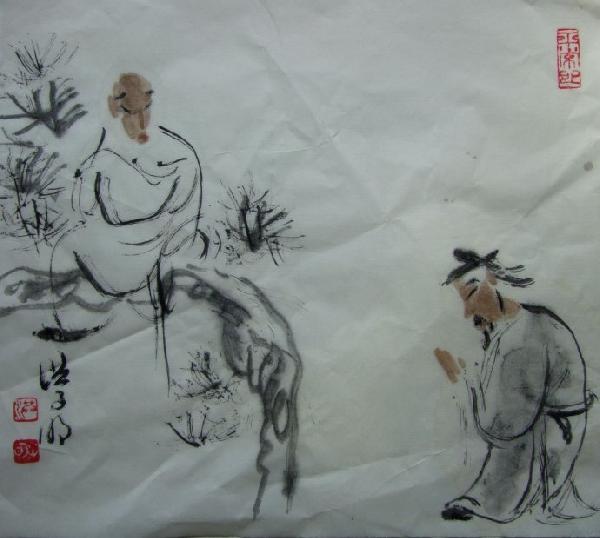
洪子明小品白居易谒鸟窠禅师
Poet Bai Juyi (772–846) visits 鳥巢道林 Niaoge Daolin (741-824) chan master
Painting by 洪子明 Hong Ziming (1953-)
Encounter Dialogues of Niaoge Daolin
compiled by Satyavayu of Touching Earth Sangha
DOC: Treasury of the Forest of Ancestors
A famous disciple of Master Daoqin's* was the hermit-monk Daolin. He was said to practice sitting meditation high in the branches of an evergreen tree, and thus earned the nickname “Master Bird's Nest.” For a while the well-known poet and government official Bo Juyi was his student, and once he came to visit the master at his tree-sit. Bo asked, “Master, isn't it dangerous up there”
The master replied, “Isn't your position more dangerous?”
Later Bo asked, “What is the essence of the teaching?”
The master replied, “Never do any evil, always do good, and purify the mind.”
Bo said, “Yes, but any child of three knows enough to say that.”
The master said, “A three-year-old can say it, but a man of eighty still doesn't practice it.”* Jingshan Daoqin 徑山道欽 (715–792) [Kinzan Dōkin]
![]()
Niao-ko Tao-lin (Madárfészkes mester) története
Terebess Gábor fordítása
Napút, 2014. március - XVI. évfolyam 2. szám, 19. oldal
Niao-ko ágakból rótt magának alvóhelyet egy fenyőfán, ezért Fészkes mesterként emlegették. Tanítványa, Huj-tung évekig tanyázott a közelében, végül megunta, hogy mesterétől nem kap semmiféle oktatást.
- Hová indulsz? – kérdezte tőle Niao-ko.
- Hiába lettem csan szerzetes, nem tanítottál semmire. Keresek másik mestert.
- Egy csekélyke csant azért én is nyújthatok - mondta Niao-ko, azzal felcsípett fészkéről egy tollpihét és feléje fújta.
Huj-tung hirtelen megvilágosult.*
*Terebess Gábor kapcsolt haikuja:
az a tollpihe
madárfészek szószékről
ritka nyomós érv
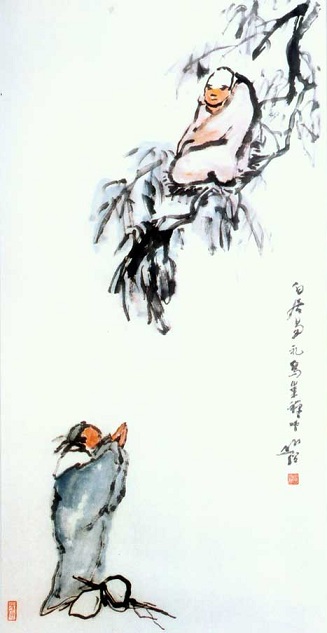
Madárfészkes mestert meglátogatta Po Csü-ji, az ismert költő és kormányhivatalnok:
- Mondd, nem veszélyes odafönn? – kérdezte a fészkén ülő mestert.
- A te helyzeted odalenn még veszélyesebb.
- Mi a tanításod veleje?
- „Kerüld el a rosszat, cselekedj jót szüntelen, és tartsd tisztán az elméd.”
- Ezt egy hároméves gyerek is tudja.
- Egy hároméves gyerek is fejből fújja, de egy nyolcvanéves aggastyán se gyakorolja.
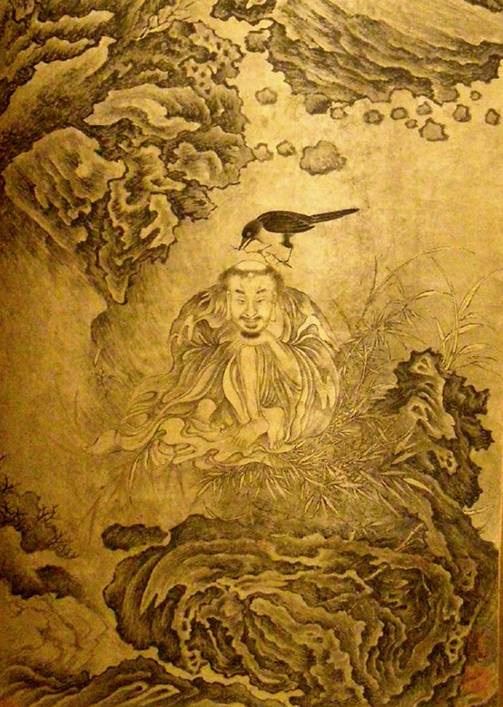
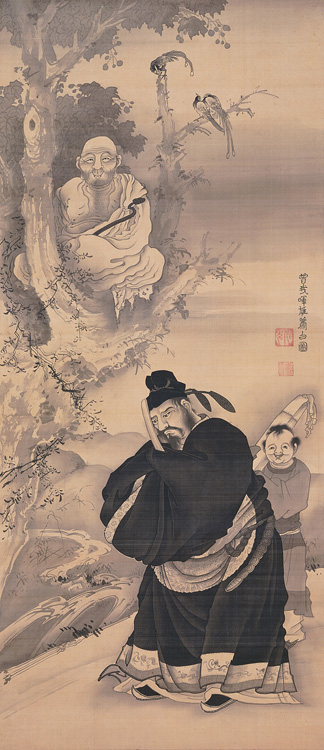
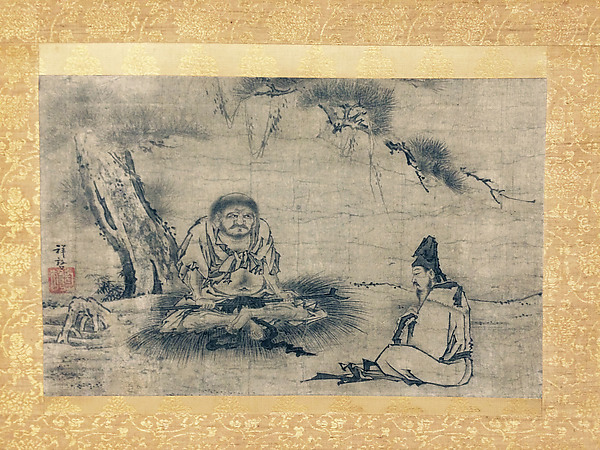
禅機(鳥窠道林・白居昜)
Zen Encounter (Niaoke Daolin and Bai Juyi)
Attributed to 賢江祥啓 Kenkō Shōkei (aka Kei-Shoki) (Japanese, active ca. 1470–after 1523)
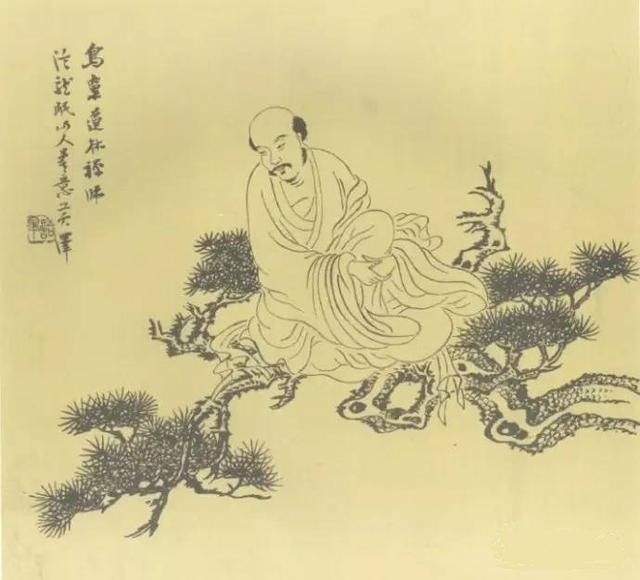
Sketch by 黃澤 Huangze (1924)
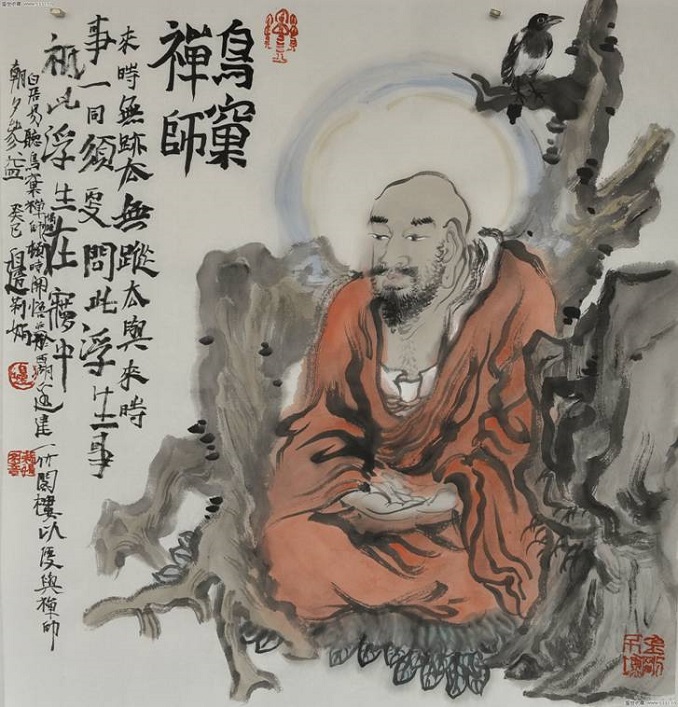
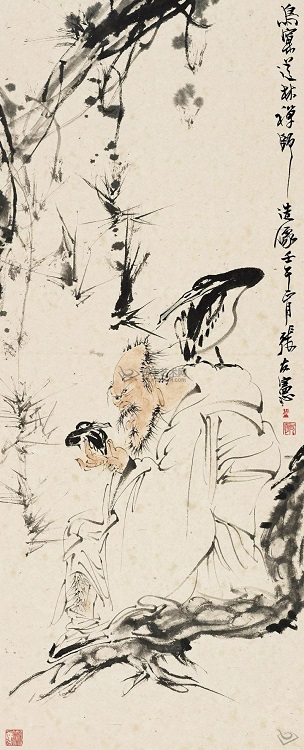
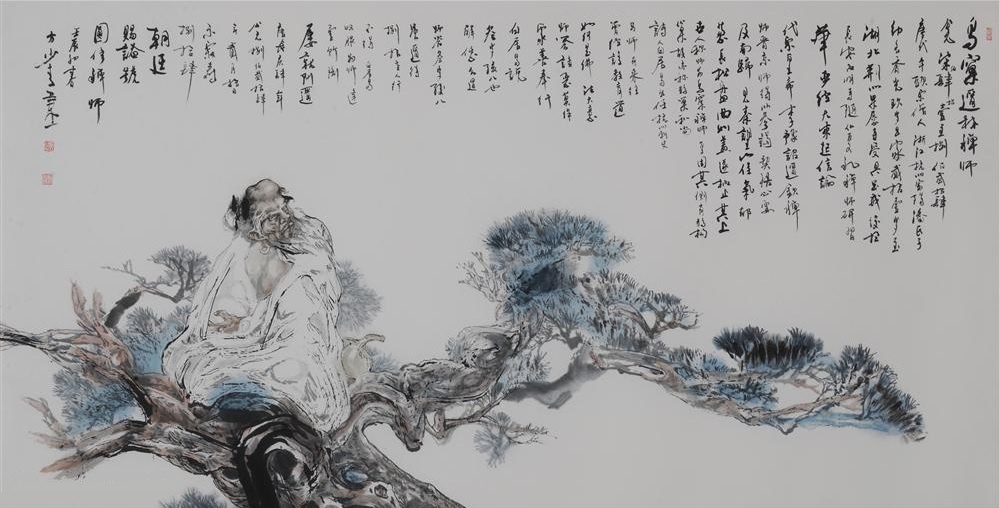
Painting by 方少青 Fang Shaoqing (1960-)